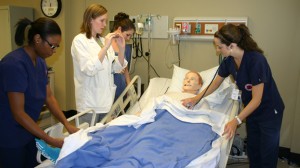
Students from the University of Mississippi schools of Pharmacy and Nursing work together to treat a patient scenario simulated by the SimMan 3G. Photo courtesy of the School of Pharmacy.
OXFORD, Miss. – The University of Mississippi schools of Pharmacy and Nursing have developed a collaborative health care simulation program that is unique among university liberal arts campuses.
“Patient simulation is increasingly used in health care education today, and we have a great opportunity for nursing and pharmacy students to work and learn together on our Oxford campus,” said Matthew Strum, clinical assistant professor of pharmacy practice.
Strum and another clinical assistant professor of pharmacy practice, Anastasia Jenkins, worked with Jennifer Hitt, assistant professor of nursing, and Lesley Thweatt, a nursing training specialist, to develop the program to provide more interdisciplinary education within both schools and enable their students to work together in a low-risk situation.
“The students are able to work on a ‘patients’ without having to worry about harming them,” Thweatt said. “It bridges the gap between education and actual clinical work.”
During clinical practice experiences in their final year of school, pharmacy students often work alongside nursing, medical and other health care students in a variety of patient-care settings, including several at the University of Mississippi Medical Center in Jackson.
“As a preceptor for pharmacy students at Baptist Memorial Hospital-North Mississippi, I have seen the pharmacy students’ excitement when they are able to collaborate with those in other disciplines,” Jenkins said. “Providing this experience earlier in the curriculum allows those in both disciplines to more thoroughly understand the roles of their fellow health care providers.”
The School of Nursing, which is headquartered at UMMC but offers classes in Oxford, has a simulation laboratory in Kinard Hall on UM’s main campus.
“It’s a lot easier to do interdisciplinary work on a health sciences campus, such as UMMC, where, you have the resources from other health care departments, such as medicine,” Hitt said. “Here (in Oxford) it’s quite different because you don’t have those resources.”
The joint program was implemented in spring 2012 using a SimMan 3G, an advanced, high-fidelity patient simulator that can run a wide range of scenarios including asthma, seizures and diabetes.
Before the first 36 students entered the lab last spring, they were given descriptions of four simulated patient scenarios to review. Then students formed teams comprised of two nursing students and two pharmacy students, which worked together to optimize their “patients'” health status. While nursing students were given the task of client care, pharmacy students were used for medication consulting.
“We attempted to set the room up like it would be set up in a hospital,” Strum said. “There was a pharmacy station off to the side, and the nursing students were in the room with the SimMan. We were able to talk through the SimMan and truly simulate being a patient. It has a microphone, so we were actually able to hear what the students were saying.
The experience was eye-opening for both pharmacy and nursing students, Hitt said.
“The students really enjoyed working together,” she said. “They learned a lot about the different responsibilities of pharmacists and nurses. The nursing students didn’t realize that pharmacists come in and do consultations. It’s great that they can get this kind of experience before they go out into the real world.”
Students were surveyed after participating in the simulation. All 31 students completing surveys said that more interdisciplinary education should be offered, and the majority of them indicated simulation was their primary choice for such education, rather than seminars, traditional lectures or laboratory activities.
Jenkins and Hitt presented a poster on the program titled “Implementing an Interdisciplinary Simulation Program on a Liberal Arts Campus: A Pilot Program with Survey Results” at the Jan. 26-30 International Meeting on Simulation in Healthcare in Orlando, Fla.
Strum hopes the poster provided insights into the challenges of teaching health care on a liberal arts campus.
“Health care can be taught on a liberal arts campus,” he said. “You just have to be creative and find unique ways to do it.”
UM pharmacy and nursing faculty members plan to continue to collaborate on this and other projects.
“We’ve already done some seminars and insulin training together,” Strum said. “We hope to do more of this kind of work together.”